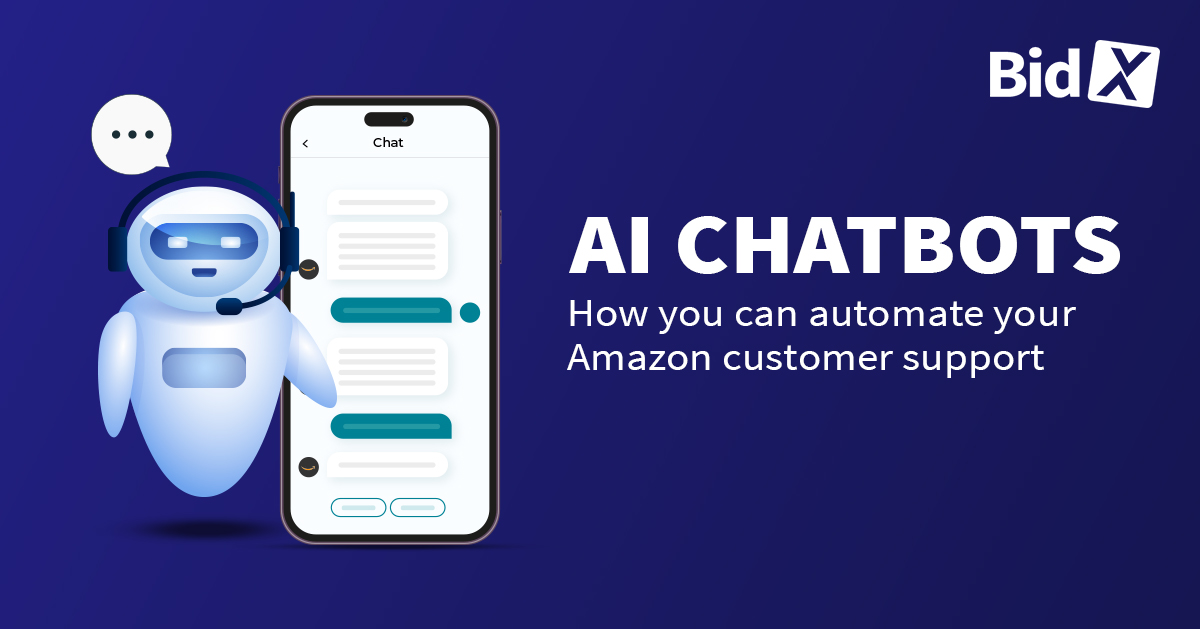AI chatbots: How you can automate your Amazon customer support
E-commerce is growing rapidly, especially on Amazon. The role of customer service is more important than ever to ensure customer satisfaction and increase sales. Amazon sellers face the challenge of building efficient customer support structures that are both fast and helpful. The use of Artificial Intelligence (AI) and chatbots has proven to be an effective solution to overcome these challenges. In this article, we will explore how Amazon sellers can use chatbots and AI to automate and improve their customer service.
This guide is aimed at e-commerce experts and Amazon sellers, both experienced and new to the industry. While we look at the use of AI in customer service, it is also interesting to look at how Amazon is evolving as a platform and whether it will still offer a good opportunity for sellers in 2024.
Table of contents
- Basics and advantages of chatbots in customer service
- Selecting and implementing the right chatbot
- Challenges and potential solutions
- Case Study: Optimization of customer support at Amazon retailer "TechGadgets"
- Measuring success and optimization
- Conclusion
- FAQ
Basics and advantages of chatbots in customer service
In e-commerce, fast and accurate customer service responses are crucial. Chatbots, powered by advanced artificial intelligence, are revolutionizing the way customer support is conducted on platforms like Amazon. Amazon sellers can not only increase their efficiency by using chatbots, but also increase customer satisfaction. In this section, we take a look at the basics of chatbots, the benefits they offer, and how they can be used in customer service on Amazon.
In addition to direct communication, chatbots and AI technologies can also be used for advanced data analysis to improve customer service. An interesting article on this is "AI forecasting: Predicting bestsellers on Amazon through data analysis", which shows how data analytics and AI can be used to predict future bestsellers and customer preferences.
What are Chatbots?
Chatbots are computer-based programs that can hold conversations with users in natural language. They use artificial intelligence (AI) and machine learning to understand questions and provide relevant answers. In e-commerce, they are used to automatically answer customer service queries, which shortens response times and increases efficiency. Examples of their use range from answering simple product questions to helping with more complex issues such as order tracking or processing returns.
Advantages of chatbots for Amazon sellers
Chatbots offer Amazon sellers a number of advantages. They are available round the clock, which means that customer queries can be dealt with at any time, regardless of the working hours of the customer service team. This leads to higher customer satisfaction and improves the overall customer experience. Chatbots can also handle a large number of inquiries simultaneously, which increases efficiency and reduces the workload of the customer service team. The constant availability and quick responsiveness of chatbots helps to promote positive customer reviews, which in turn boosts trust in the retailer and product offerings.
Areas of application for chatbots in Amazon customer service
Chatbots can be used in various areas of Amazon customer service. They are particularly effective at answering frequently asked questions, reducing response times and providing customers with the information they need quickly. In the area of order tracking, they can automatically provide status updates and assist in the processing of returns and refunds, resulting in a smoother customer experience. By automating these processes, Amazon sellers can use their resources more efficiently and focus on improving other areas of their business.
Selecting and implementing the right chatbot
Choosing the right chatbot is crucial to effectively automate and improve customer service. Amazon sellers need to consider a variety of factors to ensure their choice meets the specific needs of their business. These include integration with Amazon Seller Central, cost and scalability, and the ability of the AI to learn. In this section, we will look at how to select and successfully implement the right chatbot for your customer service. We will explain the decisive criteria and provide a guide for the entire process.
Criteria for selecting a chatbot
Choosing the right chatbot starts with defining the criteria that are crucial for your business. Consider the bot's range of functions and check whether it can be adapted to the specific needs of your customer service. Integration into existing systems is another critical point, as is the cost and scalability of the tool. Make sure the chatbot is compatible with your existing customer service tools and CRM systems to ensure a seamless workflow.
Steps for implementing a chatbot
Implementing a chatbot requires careful planning and goal setting. Start by defining clear goals that you want to achieve with the chatbot and then select the right provider and the right tool. Take the previously defined criteria into account. After the selection, the next step is to set up and configure the chatbot. This should be done in close cooperation with the provider to ensure that all functions are used optimally and that the chatbot is correctly integrated into your existing systems.
Implementing a chatbot requires careful planning and goal setting. Start by defining clear goals that you want to achieve with the chatbot. After selecting the right tool, set up and configure the chatbot. This should be done in close cooperation with the provider to ensure that all functions are used optimally and that the chatbot is correctly integrated into your existing systems.
Best practices for the use of chatbots
After implementation, it is crucial to continuously monitor and optimize the chatbot. This includes training and adjusting the AI algorithms to improve the bot's performance and ensure it responds correctly to customer requests. Also make sure to ensure data protection compliance at all times. This can be achieved by regularly reviewing and updating privacy settings and practices. By following these best practices, you will ensure that your chatbot contributes effectively to the success of your customer service.
Challenges and potential solutions
The implementation of chatbots in customer service, especially on platforms such as Amazon, offers numerous benefits, but also brings challenges. It is crucial for Amazon sellers to recognize potential difficulties and proactively find solutions to maximize the effectiveness of their customer support. In this section, we highlight common challenges when using chatbots and offer concrete solutions, supported by examples, figures and statistics where possible.
Lack of personalization and human touch
A common problem with chatbots is the lack of personalization and human touch, which can lead to an unsatisfactory customer experience. According to a study by PwC, 59% of consumers prefer human interaction when it comes to customer service. To overcome this, Amazon sellers should implement AI chatbots that are able to learn from previous interactions and personalize conversations. In addition, a "handoff" function can be implemented to transfer customers to a human employee when needed.
Difficulties in understanding complex requests
Chatbots may have difficulty understanding and correctly answering complex or ambiguous customer queries. To address this problem, it is important to continuously train and fine-tune the AI models. This can be done by analyzing chat transcripts and customer feedback. Amazon sellers should also ensure that the chatbot is able to recognize its limitations and promptly redirect to a human agent when needed.
Security concerns and data protection
Security and data protection are of paramount importance when using chatbots, especially when it comes to customer data. Amazon sellers must ensure that their chatbot solutions meet the latest security standards and are fully compliant with data protection laws. This includes storing customer data securely and ensuring that all data transmissions are encrypted. By taking proactive measures and regularly reviewing security protocols, customer trust can be strengthened and the risk of data breaches minimized.
Case study: Optimization of customer support through a chatbot at the Amazon retailer “TechGadgets”
Starting point:
TechGadgets (name changed) is an up-and-coming seller on Amazon that specializes in the sale of electronic products. As the business grew, so did the volume of customer queries, resulting in longer response times and a strain on the customer support team.
Objective:
TechGadgets wanted to increase the efficiency of customer support, reduce response times and improve customer satisfaction without having to hire additional staff.
Solution - Integration of a chatbot
TechGadgets decided to implement an AI-driven chatbot to automatically answer repetitive and simple queries and relieve the support team.
Steps to implementation
- Choosing the right chatbot
TechGadgets evaluated various providers. After a comprehensive market analysis, they finally decided on "Re:amaze", a chatbot developed specifically for e-commerce companies. Re:amaze offers a wide range of functions that are perfectly tailored to the needs of an Amazon retailer. The bot offered seamless integration with Amazon Seller Central and supported natural language processing (NLP) for a better understanding of customer queries.
- Integration and access
To enable a chatbot to access Seller Central, it must be integrated via the Amazon MWS (Marketplace Web Service) API or the newer Selling Partner APIs. These APIs provide an interface through which the bot can access relevant data and functions. It is crucial that the chatbot is configured so that it does not store sensitive customer data or use it inappropriately.
- Training and configuration
The TechGadgets team worked closely with the provider to train the chatbot and configure it with answers to the most frequently asked questions. They also determined for which types of requests the bot should initiate a "handover" to a human employee.
Answering customer inquiries:
- Retrieve incoming requests
The chatbot can regularly scan the Seller Central account for new customer requests by retrieving the relevant API endpoints.
- Processing and response
When a new request is recognized, the chatbot processes the text of the request using its AI and NLP algorithms. It then generates a suitable response based on this analysis.
- Send reply
The generated response is sent back to Seller Central via the API and displayed to the customer as an answer to their query.
Results:
- Improved response times
By using the chatbot, TechGadgets was able to reduce the average response time to customer inquiries from 17 hours to under 1 hour.
- Higher customer satisfaction
The fast response times and round-the-clock availability of customer support led to a measurable increase in customer satisfaction.
- Relieving the customer support team
TechGadgets' customer support team was now able to focus on more complex requests and tasks, resulting in greater job satisfaction and efficiency.
Summary:
Thanks to the successful integration and use of an AI-driven chatbot, TechGadgets was able to significantly optimize its customer support on Amazon. The improved response times and higher availability of support contributed to increased customer satisfaction and ultimately to better sales figures. This case study is an impressive example of how the use of AI and automation can help scale customer support while improving the customer experience.
Measuring success and optimization
The adoption of chatbots in customer service is an ongoing process that requires regular monitoring and optimization to ensure they are effectively contributing to customer satisfaction and business performance. Amazon sellers need to define clear criteria and metrics to measure the success of their chatbot initiatives and identify areas for improvement. In this section, we will present methods and tools required to measure the success and optimization of chatbots, supported by examples and statistical data.
Definition of KPIs and success metrics
To measure the success of chatbots, Amazon sellers need to define clear key performance indicators (KPIs) and success metrics. These include response times, customer satisfaction scores and the number of successfully resolved queries. For example, a goal could be to reduce the average response time by 20%. By continuously monitoring these metrics, retailers can evaluate the performance of their chatbots and identify areas for improvement.
Customer feedback and ratings
Customer feedback is a valuable resource for evaluating the effectiveness of chatbots. Amazon sellers should regularly analyze customer reviews, especially comments about their customer service. Negative reviews or recurring complaints about the chatbot service may indicate problem areas that need to be addressed. To proactively gather feedback, merchants can also conduct short surveys after a chatbot dialog is completed and ask customers to rate their experience.
A/B testing and continuous improvement
A/B testing is an effective way to optimize different aspects of a chatbot, from the wording to the recommended solutions. Amazon sellers can test different versions of their chatbot to find out which has the highest success rates. By continuously running A/B tests and adjusting based on the results, merchants can constantly improve the performance of their chatbot, increasing customer satisfaction and customer service efficiency.
Conclusion
Chatbots are playing an increasingly important role in customer service for Amazon merchants by providing efficient and cost-effective support. Their ability to respond to customer queries around the clock not only improves customer satisfaction, but also optimizes workflows and increases efficiency. When selecting and implementing a chatbot, retailers should proceed carefully to ensure that the bot meets the specific requirements of their business and can be integrated into their existing systems.
While chatbots are a valuable addition to customer service, they cannot completely replace human contact. Especially for more complex requests, human intervention is necessary. Continuous monitoring and optimization of the chatbot are essential to maintain the quality of customer service and take full advantage of this technology. Retailers who are able to keep up with the constant developments in chatbot technology and adapt their systems accordingly will gain a clear competitive advantage. The use of chatbots on Amazon is therefore a strategic decision that has the potential to increase customer satisfaction, improve efficiency and ultimately contribute to the company's success.
FAQ
What are the main advantages of chatbots in customer service on Amazon?
Chatbots offer Amazon sellers the opportunity to process customer inquiries quickly and efficiently around the clock. They increase customer satisfaction, increase efficiency in customer support and help to reduce costs. Chatbots can process simple to complex inquiries, allowing employees to concentrate on more demanding tasks.
What criteria should I consider when choosing a chatbot?
The selection of a chatbot should be based on its capabilities, adaptability to specific needs, compatibility with existing systems and scalability. The cost and functionality of the bot also play an important role. It is crucial that the chatbot is able to interact efficiently with customers and can be integrated into existing customer service tools.
How do I implement a chatbot in my customer service on Amazon?
The implementation of a chatbot requires a clear objective and careful planning. Once a suitable chatbot has been selected based on the defined criteria, it is set up and configured. It is important to continuously monitor, train and optimize the chatbot to improve its performance and ensure a high level of customer satisfaction.
Can a chatbot completely replace human interaction in customer service?
Although chatbots are able to process a large number of customer inquiries and improve customer service, they cannot completely replace human contact. Human intervention is still necessary for more complex inquiries and problems. Chatbots serve as a valuable addition and support in customer service, not as a replacement.
How do I measure and optimize the success of a chatbot?
The success of a chatbot can be measured using key figures such as customer satisfaction, response time to inquiries and the resolution rate. In order to optimize the performance of the chatbot, it is crucial to continuously collect and evaluate data and adapt the bot accordingly. This can be achieved by training the AI algorithms, adapting the response scripts and revising the frequently asked questions.
About the Author
Florian Schneider is a long-standing e-commerce retailer and expert in building brands on Amazon. He also offers strategic advice on e-commerce topics for digital start-ups and companies. On his blog, he writes insightful content about online entrepreneurship with a focus on e-commerce and digital marketing.





